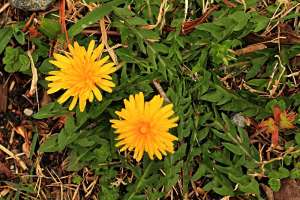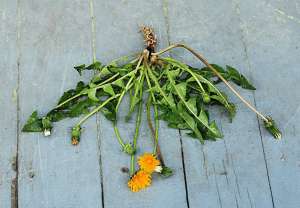Dandelions are sort of a gateway plant into foraging. They’re easily recognizable, tasty, and probably the most common weed in the United States.
Like lots of our common weeds, the dandelions of our yards and gardens are not native.
Many of our non-native weeds arrived in North America by accidental migration, as their seeds stowed away on the treads of boots and the cargoholds of ships generations ago.
But the Common dandelion was intentionally introduced, brought by European settlers on the Mayflower, a testament to its value as food and medicine.

Common dandelion, Taraxacum officinale
I’ve always heard that Native Americans adopted the dandelion as a food source after its introduction by Europeans, but I’m not sure that’s completely accurate.
North America does have native dandelions, so I believe it was probably a somewhat familiar plant.
What we did not have prior to European settlement in North America was Taraxacum officinale (Common dandelion), the Eurasian species that is widely cultivated throughout the world.
I’m sure its introduction was welcomed by Native Americans, as it has a propensity to colonize disturbed areas without cultivation, which would have made it more readily available than native species.
Its inclination to take over has made it infamous as a noxious weed among gardeners and yard aficionados, although it’s really not considered invasive.
Identification
Latin Name: Taraxacum officinale
Family: Asteraceae or Compositae
Leaves:
The leaves of the dandelion grow from a basal rosette. Mounted on short stems, they're deeply toothed, teeth pointing backwards.
Flowers:
The flowers are golden yellow, round and formed in a ray of florets that are 1-2 inches wide.
There can be up to 10 flowers per plant.
Each flower blooms on top of a single, hollow stem that rises above the leaves.
The stems exude a white latex substance when broken.
Fruits:
Tiny olive or yellow fruits, each containing one seed, are located on the end of a cluster of wispy white hairs -- the familiar puffball that a lot of us blew into the wind as kids.
Roots:
Dandelion roots grow from a long, single taproot that has been known to go as deep as 18” under ideal conditions.
Look-alikes
There are a few dandelion look-alikes, but the good news is that none of them are poisonous. Several are even edible.
Two common look-alikes are:
- Cat’s ear (Hypochaeris radicata), which has very similar flowers, but has branching stems that are not hollow
- Sow thistle (Sonchus Spp.), which grows much taller and has hairy leaves that grow off of the stem, rather than from a basal rosette, like the dandelion
Habitat
Common dandelions aren’t super picky about where they grow.
They will tolerate partial shade but prefer the full sun of open areas like forest clearings, fields, lawns, and other disturbed lands.
Their ability to grow in compacted dirt is actually good for the soil structure, as their roots help to loosen it.
In the city, you can often find dandelions growing between cracks in the concrete, but they do need sufficiently damp soil to thrive.
Range
In the United States, Common dandelions grow in all 50 states.
How to Harvest
All parts of the dandelion are edible.
Harvesting leaves:
Dandelion leaves are prime for harvest when young before the plant blooms in the spring and in the cooler days of early fall.
The leaves are less bitter when harvested young like this, but you can harvest them throughout the growing season, as well.
Plants that grow in partial shade will also be milder than those growing in full sun, but various cooking methods can help take away the bitterness.
Use a small knife or scissors to cut away leaves at the base. Always leave enough leaves to continue to give nutrients to the plant for regrowth.
Freshly picked and washed leaves can be stored in a bag or container in the fridge for about two days.
Harvesting flowers:
Harvest the flowers by snipping the stems at the base.
They should be picked when they’re at their prime –- bright yellow, plump and beautiful, at midday after the dew has dried.
Don’t wait too long to harvest, or your flowers may go to seed before you can use them.
If you don’t plan to use them immediately, keep the stems in a cup of water, or pluck the flower heads and place them in a bowl of water to prevent them from closing up before using. They’ll keep in water in the fridge for a few days.
If you plan to dry them, pluck the flower only and do not put in water.
Harvesting roots:
Roots can be harvested at any time, but they’re best dug in the late fall, when leaf production and flower production have slowed or stopped and the energy of the plant has descended downward.
Find a mature plant, grab all leaves at the base and pull straight up to bring the long taproot out of the soil.
If soil is compacted, you may need a trowel or hori hori knife to dig around the perimeter of the plant.
Any bits of root left behind will grow new plants.

How to dry or dehydrate
Drying leaves:
To dry the leaves, first wash them and pat dry with a paper towel.
They can then be tied in a small bundle with string or fastened with a rubber band to hang in a dry area away from sunlight for a few days.
You can also arrange them in a single layer in a basket or on a dry cloth to dry. A basket works better, as it allows air to circulate under the leaves.
When thoroughly dry, place in a glass jar and store in a dark place to retain color for up to a year.
Dried leaves can be used for tea, in soups and stews or for tinctures.
Drying flowers:
Dry the flowers by spreading them in a single layer in the sun. Or put in a basket or on a cloth in a dry area overnight like you would for drying leaves.
The petals will close slightly and look and feel dry, but make sure they’re completely dry before storing or using to avoid the possibility of mold.
Drying can be tricky. If left too long, the flower will start going to seed, so timing can be critical.
Drying roots:
Before drying, clean roots thoroughly, and then cut into thin strips.
Use a dehydrator at 95 degrees to dry until brittle.
You can also air-dry them by laying them out on a screen in an airy, dry place out of direct sunlight until dry.
Once dry, store them in a glass jar for up to a year.
How to cook/eat
Leaves: Young dandelion leaves are the most tender and mild tasting, which makes them great for eating raw in salads or making pesto.
Young leaves that are not bitter only need to be washed to be eaten fresh in salads or any way you might use a fresh green.
Older leaves will be more bitter, but cooking can help take away the bitterness.
Young and older leaves can be boiled or braised in a variety of dishes using the oils, herbs and spices of your choice.
A popular salad in Greece, Radikia, uses boiled dandelion leaves. After boiling, the greens are used for the salad and the liquid is then drunk as tea.
Flowers:
There are countless creative ways to enjoy dandelion flowers, but I’ll mention a few of the more common uses.
Before using flowers for anything, it’s a good idea to give them a gentle tap to jar loose any tiny insects.
Tea is probably the quickest and easiest way to partake of dandelion flower goodness. To make tea, fill a mason jar with flowers, pour boiled water over them, and let steep until it’s cool enough to drink.
You can also eat the flowers raw — they’re sweet and a little crunchy, which makes them a nice, beautiful addition to salads.
Another common use is dandelion wine, an age-old tradition that requires a large quantity of flowers. Early spring is the time to gather blossoms for wine, when it’s fairly easy to find hundreds in a single lawn or field.
And then there are fritters. Mix the flowers in an egg batter, and then fry and serve with honey or applesauce.
Or you can make dandelion jelly or syrup and eat it on your fritters.
The petals can also be mixed into baked goods or incorporated into hamburgers or meatloaf recipes.
Roots:
Roots can be used fresh or dried.
Dried, roasted roots can be used as a coffee substitute.
Before using the roots fresh, they need to be peeled or scrubbed of their outer skin.
Prepare them any way you might cook carrots or parsnips –- boiled, roasted or baked — or put in a pickling brine for later use.
All parts together:
A great way to reap the benefits of the dandelion is to make infused vinegar using the whole plant (or any combination of parts).
First, rinse the leaves and scrub the root to remove all soil, and tap the flowers to rid them of insects.
Make certain all parts are patted dry, and then place in a jar and cover with your favorite vinegar.
Apple cider vinegar with the mother is our favorite. Put a lid on the jar and set in a dark, cool place for about six weeks.
Then strain and store to use. It’s great on salads, in soups and stews, or any recipe in which you would use vinegar.
It’s also great to take a tablespoon here and there just like you would take cider vinegar by itself.